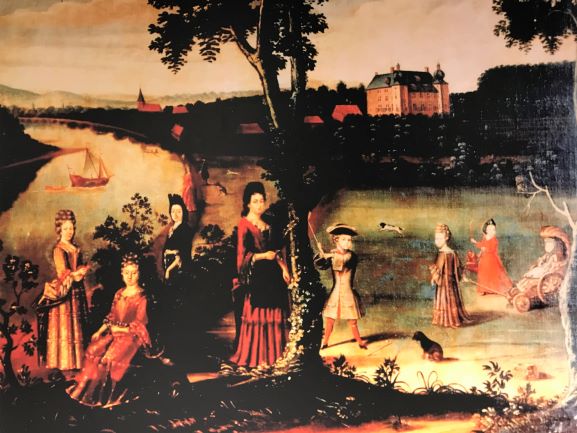H. Golt: Haus Wohnung (1706)
The replica you see here is part of an oil painting by H. Golt from 1706 and shows the first wave image from Germany.
Haus Wohnung can be seen near the town of Voerde on the Lower Rhine. Originally a moated castle from the late Middle Ages, but in its current state a reflection of the architecture of the late seventeenth century when the owner had the entire building refurbished.
Haus Wohnung was the residence of the local nobleman Johann Carselis von Ulft, named Doornick.
The painting looks at the building with two towers from the southwest and from a position on the eastern bank of the Rhine. In the lower right corner is the date 1706 on a stone.
It is conceivable that Mr Johann had the painting made to commemorate the completion of the extensive renovation of his home. It is also conceivable that Mr. Johann may have wanted to express his gratitude to his mother-in-law, the widow Sophia Heilwig von Lynden, who had given him the stately mansion.
She is probably in the precious, festive red dress in the left corner. To her left is her daughter Johanna Maria, wife of Mr. Johann. The identical hairstyles indicate the close relationship between the two. The two unmarried sisters, Woltera Stephania and Elisabeth Katharine, who both lived in the house, are also clearly recognizable.
Woltera Stephania had died in February 1705, a year before Golt finished his painting. The fact that she is in the painting may have been a conscious attempt to pay her a lasting tribute.
The nickname of the lord of the castle can be guessed, which is said to have been derived from the village of Tournai, which is just over 16 km north of Afferden. This painting could therefore very well show the game of golf as it was played in and after the time of Pieter van Afferden.
The golf scene is truly remarkable. Lord Johann had designed a golf course in his garden to the south of his home: a large fenced rectangle with a carefully trimmed lawn. Under the tree in one of the corners of this field, his son, the young Reiner Johann Theodor, is about to knock a golf ball off a tee.
However, that tee is not just any tee, but an advanced device with a hollow top in which players laid their ball before they struck. Attached to a pen, which was inserted into the turf at an angle and roughly anticipated the court of the ball. Possibly this device made it easier for a player to hit a ball well.
The young Reiner is depicted making a powerful swing at the ball. As befits a young man of his status, he wears the clothes of an adult, which in turn bears a strong resemblance to the clothes that golfers wore on the earliest Scottish golf images (1680 or 1720 and 1746/1747).
The colfstok of the young Reiner and of the Scottish golfers is comparable to seventeenth-century clubs, which have stood the test of time.
Origin:
- Dr. Heiner Gillmeister in ‘About the Origin of Golf’
- Steag AG, Heiner Gillmeister, Robin Bargmann

